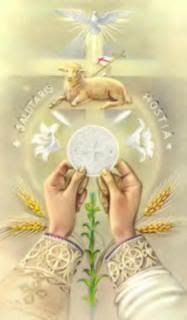
In celebration of the imminent freeing of the Old Roman Rite by Pope Benedict the Great, I’ve returned again to one of my favorite subjects, the Mass. I’ve just read The Heresy of Formlessness by Martin Mosebach, a German novelist. It is one of the best defenses of the Old Roman Rite I’ve ever read. And the fact that it is published by Ignatius Press, one of the leading lights of the neo-Catholic “reform of the reform” crowd, is stunning. As Fr. Joseph Fessio, the editor-in-chief of Ignatius explains in his foreword to the book, “We do not concur with every particular judgment Martin Mosebach makes or every conclusion he comes to. But we believe he has eloquently expressed a genuine and profound problem at the heart of the Church’s life.” And that problem would be, the abrupt jettisoning of the Church’s precious liturgical patrimony in the name of “renewal.” Ummm….sorry, Father. That argument rings hollow to me. There’s something more going on here in Ignatius’ printing of this no-holds-barred clarion call for a full restoration of the Traditional Mass. Perhaps Fessio is a closet traddy and has been all along. Perhaps he can’t publicly declare it openly, lest he be excommunicated from the EWTN/Catholic Answers Axis of Weevils. Perhaps he can only hint at it and occasionally publish unapologetic traddy tomes like the present volume, while burying it amidst a bunch of “this time we’ll get the novus ordo right” codswallop. Maybe that explains why he ran afoul of the hand-swaying charismatics at Ave Maria. Ah, yes. It all makes sense now, does it not? But I digress.
Regardless of why Fr. Fessio committed his neo-Catholic publishing powerhouse to printing this volume, we should be grateful that it is available to us in English. Mosebach wastes no time targeting 40 years worth of liturgical barbarians, renewal regurgitators and those who see springtimes where none exist and destroying them with Teutonic precision. For example:
- “If people who have been kneeling for a thousand years suddenly get to their feet, they do not think, ‘We’re doing this like the early Christians, who stood for the Consecration’; they are not aware of returning to some particularly authentic form of worship. They simply get up, brush the dust from their trouser legs and say to themselves, ‘So it wasn’t such a serious business after all.’” (p. 30)
- “What did the disciples’ ‘active participation’ consist of in the Upper Room, when they let Christ wash their feet? What was the ‘active participation’ of Mary and John as they stood beneath the Cross? It consisted of beholding, letting it happen, watching and praying.” (p. 82)
- “The Council of Trent, in its teaching concerning the liturgy’s sacred rites, said that these rites ‘contain nothing unnecessary or superfluous’…At all times there have been people who made themselves ridiculous by trying to eliminate the ‘mistakes’ in masterpieces.” (p. 114)
- “Kitsch – be it in language, music, painting, or architecture – has completely swamped the outward manifestation of the Church’s public acts.” (p. 118)
- “When I see people still on their feet in front of the elevated Host, when I see them entering a church without genuflecting, and receiving Communion in their outstretched hands…I, myself, see it as a degradation, a pointed, symbolic refusal to give honor.” (p. 184)
But, the Pauline Rite lover will exclaim, the problem isn’t the new
Mosebach, however, also has some harsh words for the Traditional Mass and the manner in which it was celebrated, beginning with the counter-Reformation. “The liturgy was not interfered with, but it was allowed to fall silent. It was enveloped in an architecture in which the imagination had run riot and accompanied by orchestral music of the most contemporary kind, virtuoso concert ‘Masses’ in which the connoisseur could listen in rapt admiration to a coloratura soprano singing the Agnus Dei.” (p. 42) He criticizes the introduction of vernacular hymns, a protestant novelty, but a sentimental favorite of too many Traditionalists, especially in
At the end of the day, we Traditionalists always lament, why can we not have the transcendent, the reverent, the awe-inspiring majesty in any Catholic church anywhere in the world? Why is Mass today like a box of chocolates…you never know what ya gonna get? The answer, as Mosebach has discovered, is because of the very nature of the two rites. “The liturgy of the reform and its adornments will never be able to constitute a seminal fact in the life of the nations. It is too anemic, too artificial, too little religious, too lacking in form to do this.” (p. 121) Until our leaders recognize this fact, don’t spend time looking for a transcendent novus ordo. They exist, but you have to dig thru a lot of dirt to find the gold. It shouldn’t be that way, but it is. Deal with it.













2 comments:
Hey Dr. Bombsaway! Good to see your inimitable style again.Good post; liked this comment:“When I see people still on their feet in front of the elevated Host, when I see them entering a church without genuflecting, and receiving Communion in their outstretched hands…I, myself, see it as a degradation, a pointed, symbolic refusal to give honor.” (p. 184)
Think it's possible that we'll ever attend a perfect Mass in our lifetime? or do we just ignore all the mess and concentrate just on what is really going on at the altar-the awesome presence of our Lord?
That's all we can do, Shirley. Ignore the nonsense and focus on the miracle of the altar.
And I guess we also have to pray that the priest intends to do what the Church does. Otherwise, we have an invalid Mass.
We can only do what we can do and leave the rest up to God.
Post a Comment